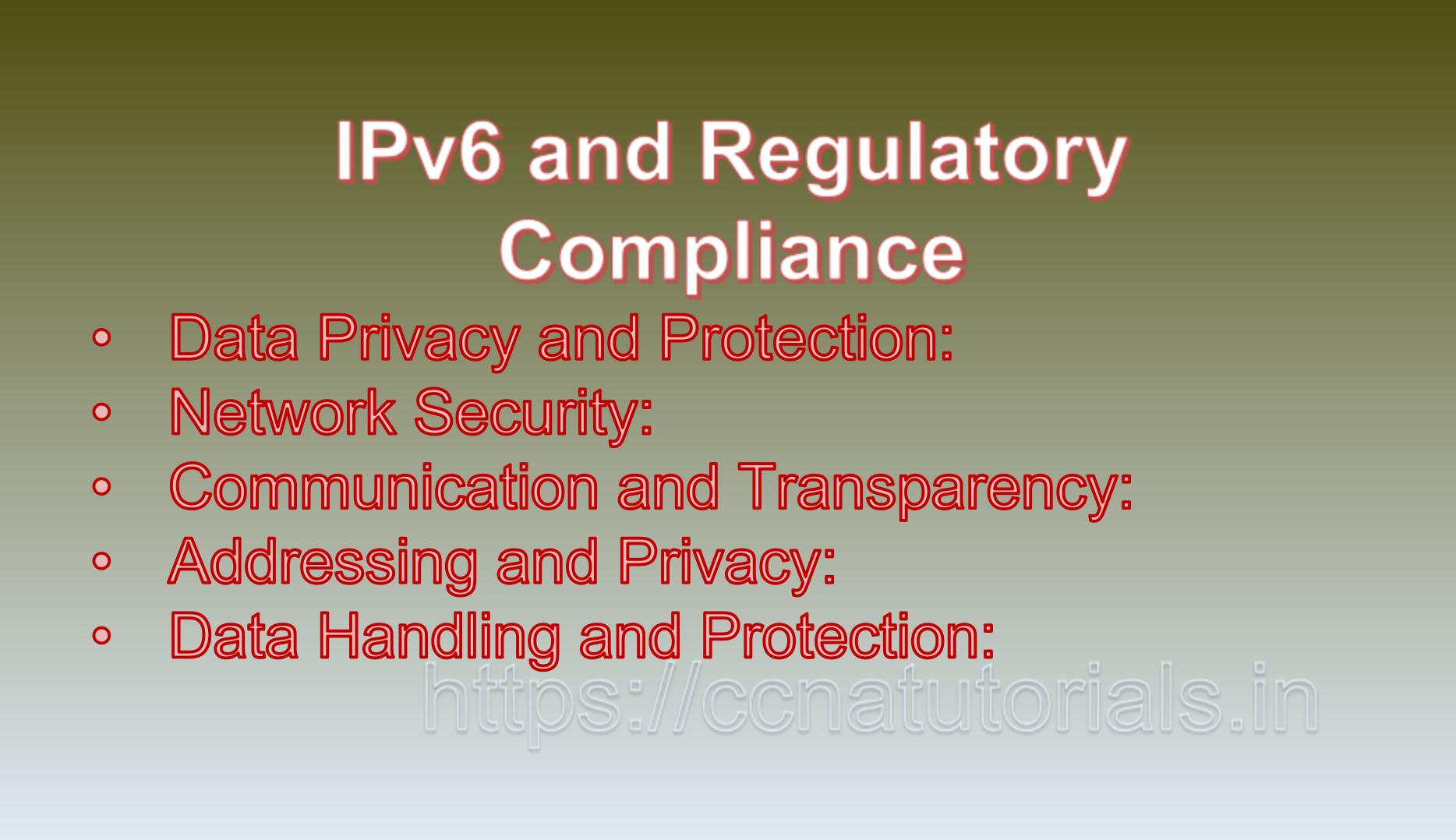Contents of this article
In this article, I describe IPv6 and Regulatory Compliance Navigating the Path to Conformity, Internet Protocol version 6 (IPv6) represents a pivotal step in the evolution of internet infrastructure, offering a larger address space and improved functionality compared to its predecessor, IPv4. As organizations transition to IPv6, they must also consider regulatory compliance requirements that govern data protection, network security, and communication. This article explores the relationship between IPv6 and regulatory compliance, highlighting the challenges and strategies that organizations can employ to ensure adherence to relevant regulations.
1. Understanding IPv6 Transition and Regulatory Compliance:
IPv6 adoption involves migrating network infrastructure, applications, and services from IPv4 to IPv6 protocols. This transition can impact an organization’s regulatory compliance efforts in various ways, such as data handling, security practices, and transparency.
– Data Privacy and Protection:
Regulatory frameworks like the General Data Protection Regulation (GDPR) and the California Consumer Privacy Act (CCPA) impose stringent requirements on the collection, storage, and processing of personal data. IPv6’s features, such as its addressing mechanism, can impact data privacy and necessitate compliance adjustments.
– Network Security:
IPv6 introduces security enhancements like mandatory IPsec and simplified header structures. Organizations need to align their network security practices with regulatory requirements to ensure the confidentiality, integrity, and availability of data.
– Communication and Transparency:
Compliance regulations often require organizations to provide clear communication about data processing, security practices, and user rights. As IPv6 deployment affects network communication, organizations must ensure that their transparency efforts cover IPv6-related changes.
2. Challenges in IPv6 Regulatory Compliance:
IPv6 adoption introduces unique challenges that intersect with regulatory compliance efforts:
– Addressing and Privacy:
IPv6’s persistent addresses raise concerns about user tracking and identification, potentially affecting compliance with regulations like GDPR. Organizations must balance the benefits of IPv6 with privacy safeguards.
– Data Handling and Protection:
IPv6’s expanded address space can lead to broader data collection. Organizations must ensure that data collection aligns with regulations and that they manage and protect collected data appropriately.
– Security Implementation:
While IPv6 incorporates security features like IPsec, organizations must ensure that their security practices comply with regulations’ requirements for data protection, network security, and incident reporting.
3. Strategies for IPv6 Regulatory Compliance:
Organizations can employ various strategies to ensure that their IPv6 deployment aligns with regulatory compliance:
– Risk Assessment:
Conduct a comprehensive risk assessment to identify potential compliance challenges introduced by IPv6 adoption. This assessment can help organizations understand the impact on data privacy, security, and communication.
– Privacy Impact Assessment:
Assess how IPv6’s addressing mechanism and features could impact user privacy. Implement privacy-enhancing strategies like IPv6 privacy extensions and temporary addresses to minimize potential risks.
– Security Integration:
Implement robust security practices that align with both IPv6 security enhancements and regulatory requirements. This includes encryption, access controls, and monitoring to safeguard data and communication.
– Data Management:
Ensure that data collection and processing related to IPv6 align with data protection regulations. Implement data minimization practices, obtain user consent where necessary, and ensure transparency in data handling.
4. Example: IPv6 and GDPR Compliance in a Healthcare Organization:
Consider a healthcare organization that is transitioning to IPv6 and must ensure compliance with GDPR:
Strategy:
– The organization conducts a privacy impact assessment to understand how IPv6’s addressing mechanism may impact patient data privacy.
Implementation:
– The organization implements IPv6 privacy extensions and temporary addresses for devices accessing patient data. This minimizes the risk of long-term tracking and supports GDPR’s principles of data protection.
Impact:
– By aligning IPv6 adoption with GDPR’s requirements, the healthcare organization demonstrates its commitment to safeguarding patient data privacy, mitigating potential risks introduced by persistent addresses.
Navigating the Convergence of IPv6 and Regulatory Compliance:
IPv6 adoption is not just a technical transition; it’s a process that intersects with regulatory compliance efforts. Organizations must navigate the convergence of technology and compliance by carefully assessing how IPv6’s features impact data privacy, network security, and communication practices. By implementing risk assessments, privacy impact assessments, and security best practices, organizations can ensure that their IPv6 deployment aligns with regulatory requirements, from data protection to transparency and beyond. As the digital landscape evolves, organizations that successfully balance IPv6 adoption with regulatory compliance will be better equipped to reap the benefits of advanced networking while maintaining trust and adherence to legal standards.

IPv6 and Regulatory Compliance: Navigating Legal and Industry Standards
Internet Protocol version 6 (IPv6) is the next-generation internet protocol designed to overcome the limitations of IPv4, primarily the exhaustion of available IP addresses. As organizations transition to IPv6 to accommodate the growing number of internet-connected devices, they must also ensure that their IPv6 implementations align with various regulatory requirements and industry standards. This article explores the relationship between IPv6 adoption and regulatory compliance, along with examples of how organizations can navigate these complexities.
1. IPv6: A Necessity for Network Growth:
IPv6’s larger address space and enhanced features make it a critical solution for the expansion of the internet. As IPv4 addresses become increasingly scarce, IPv6 adoption is essential to support the proliferation of devices, services, and applications. However, IPv6 adoption brings unique challenges related to regulatory compliance, data protection, and legal requirements.
2. Regulatory Compliance and Data Protection:
Regulatory compliance refers to the adherence to laws, regulations, and standards set forth by governmental bodies or industry organizations. The adoption of IPv6 intersects with regulatory compliance in various ways, particularly in terms of data protection and privacy:
– GDPR (General Data Protection Regulation):
GDPR is a comprehensive European Union regulation that governs the collection, processing, and storage of personal data. Organizations must ensure that IPv6 adoption aligns with GDPR principles, especially when handling IPv6 addresses that can be considered personal data.
– HIPAA (Health Insurance Portability and Accountability Act):
Healthcare organizations in the United States must comply with HIPAA regulations, which include safeguarding patients’ electronic protected health information (ePHI). IPv6 adoption within healthcare contexts requires ensuring that ePHI remains secure and compliant.
3. IPv6 and Regulatory Compliance Challenges:
IPv6 adoption introduces specific challenges related to regulatory compliance:
– Data Retention:
IPv6’s larger address space can result in longer-lasting IP addresses, potentially leading to extended data retention periods. Organizations must align their data retention policies with regulatory requirements to avoid excessive data storage.
– Personal Data Protection:
IPv6 addresses can be considered personal data, especially when they can be linked to identifiable individuals. Organizations must handle IPv6 addresses in compliance with data protection regulations, which may include obtaining user consent for data processing.
4. Examples of IPv6 Regulatory Compliance:
– Example 1: GDPR Compliance with IPv6:
A multinational e-commerce company has adopted IPv6 to accommodate its expanding online customer base. To ensure GDPR compliance, the company anonymizes IPv6 addresses in its logs, allowing it to monitor website traffic while protecting users’ privacy. Additionally, the company updates its privacy policy to inform users about the collection and processing of IPv6 addresses.
– Example 2: HIPAA-Compliant IPv6 Implementation:
A healthcare institution is transitioning to IPv6 to support its network expansion. To maintain HIPAA compliance, the institution ensures that IPv6 addresses associated with ePHI are securely stored and transmitted. It implements strong encryption for IPv6-enabled devices, protecting patients’ sensitive health information.
5. Navigating IPv6 Compliance:
To navigate IPv6 compliance challenges effectively, organizations can implement the following strategies:
– Privacy Impact Assessment (PIA):
Conduct a PIA to assess the impact of IPv6 adoption on privacy and data protection. Identify potential risks and implement mitigations to align with regulatory requirements.
– Policy and Documentation Updates:
Review and update privacy policies, terms of service, and data handling documentation to clearly communicate how IPv6 addresses are collected, processed, and protected.
– User Consent:
Obtain user consent for processing IPv6 addresses, particularly when they can be linked to personal data. Implement mechanisms for users to opt in or out of data processing.
– Encryption:
Implement encryption protocols for data transmission involving IPv6 addresses, ensuring that data remains secure during transit.
– Data Minimization:
Apply data minimization principles by collecting only the IPv6 addresses necessary for network operation and security. Avoid retaining unnecessary data that could pose compliance risks.
Conclusion for IPv6 and Regulatory Compliance, A Balancing Act for the Future:
IPv6 adoption is a necessity for addressing the limitations of IPv4 and facilitating the growth of the internet. However, organizations must navigate the complex landscape of regulatory compliance and data protection while adopting IPv6. By aligning IPv6 implementation strategies with regulatory requirements, organizations can harness the benefits of IPv6 while safeguarding user privacy, meeting legal obligations, and maintaining trust. The journey to IPv6 compliance is a balancing act that underscores the importance of harmonizing technological advancement with legal and ethical considerations in the digital age.






